Fluxes for melting aluminum cans solve the problem of excessive burning loss and waste gas pollution caused by the chemical reaction of traditional flux in alloy liquid. AdTech is dedicated to research and development, production and marketing of granular fluxes for the aluminum alloy casting process. AdTech refining fluxes utilize unique technology to enhance the traditional degassing and deslagging effect. And this technology is applied to the casting process of multi-series aluminum alloy products. Such as micron-sized aluminum foil, PS baseboard for printing, canning material, elastic packaging material, railway transportation, aerospace products, cable & wire, and other casting aluminum purifying, especially for pure aluminum and high magnesium alloys purifying.
Refining Fluxes

AdTech refining flux is a kind of white with slightly gray fine particles. The refining agent can purify the oxidation inclusions and gases in the metal to achieve the purpose of removing slag and gas. The Main ingredients are chloride with other compounds. It turns to uniform size after heat treatment and screening. Under the action of nitrogen or argon as the carrier gas, refining flux for melting aluminum cans is injected into the melt two times through the powder spraying tank. After physical and chemical changes in molten aluminum, numerous small bubbles with oxidized slag are separated and formed. The bubbles carrying hydrogen atoms slowly rise up and float out, so as to achieve the degassing and purification.
Learn MoreDeslagging Fluxes

Deslagging flux is used for deslagging for roll casting and molten Aluminum alloy, especially for A3562 alloy and wheel hub. Do not affect the metamorphism effect of strontium. The slag cleaning agent has low surface tension, good wettability to the melt surface, and is not easy to separate from the metal. In order to improve its performance and facilitate separation from metal, slag cleaning agent can be added to reduce metal loss in slag.
Learn MoreTundish Fluxes

Tundish Flux is used for inner furnace covering to prevent molten aluminum oxidation, lower oxidation, and burning loss. The covering agent is used to cover the surface of the melt, has the function of reducing metal oxidation, preventing hydrogen from being absorbed by the melt metal, and playing a protective role.
Learn MoreOxide Removal Flux

Oxide Removal Flux has granular shaped and enhanced type. It is used for removing hard slags from the furnace wall and bottom.
Learn MoreHow to Use Fluxes
Before feeding the furnace, evenly sprinkle powdered flux into the furnace bottom. After the furnace charge is leveled, evenly sprinkle a layer of dry powdery flux to cover, and sprinkle the flux on the surface of the bare metal melt in time to prevent inhalation. The flux method has a good effect on the removal of impurities, but its removal effect largely depends on the physical and chemical characteristics of the flux itself and the purification process, such as the amount of flux, the contact conditions of the flux and the melt, and the processing temperature. The adsorption capacity of flux depends on its chemical composition. As far as aluminum alloy is concerned, when other conditions are the same, the wetting and adsorption capacity of chloride is better than that of fluoride, alkali metal chloride is better than alkaline earth metal, sodium chloride and potassium chloride The mixture is better than pure chloride. Adding fluoride (such as cryolite) to the mixture of sodium chloride and potassium chloride greatly improves its adsorption capacity.

According to the purpose of using flux for aluminum alloy, the following requirements should be met when selecting and producing flux.
The melting point of the flux should be close to that of the metal, and the most ideal melting point is between the melting temperature and the casting temperature. In this way, the flux can be melted with the metal during smelting to achieve the refining effect, and it can also prevent the flux from flowing into the casting nozzle with the metal during casting and rolling. The melting point of aluminum and aluminum alloy flux is preferably 680-700℃.
The density of the flux should be significantly different from the density of the metal or alloy to be smelted, so that the flux can float or sink in the molten metal after adsorbing and dissolving oxides, and it is easy to discharge slag. For aluminum and aluminum alloys, the density of flux should be as small as possible.
Fluxes for different purposes should have different surface tensions. The surface tension of the protective covering agent should be small to increase the wettability and covering effect of the melt surface. The refining flux should have an appropriately large surface tension, so that it can not only absorb and dissolve the oxidized inclusions in the melt, but also be easy to separate from the metal melt.
The flux should have an appropriate viscosity to ensure good fluidity. so that a continuous flux protective layer can be formed quickly.
The solvent must have good refining ability, which can not only absorb and dissolve the oxidized inclusions in the melt, but also remove the gas in the melt. The moisture absorption of the flux should be as small as possible, and the flux should not chemically react with the molten metal or alloy.
